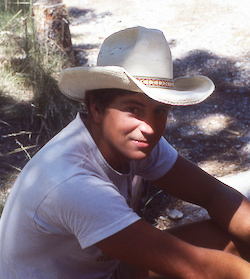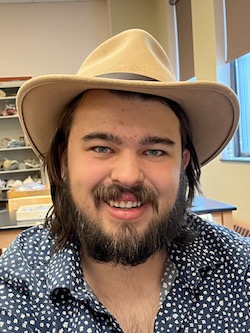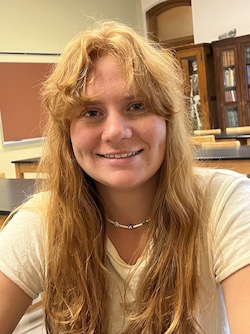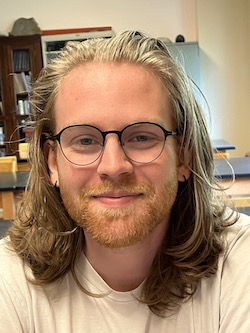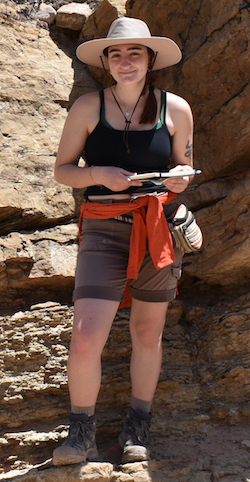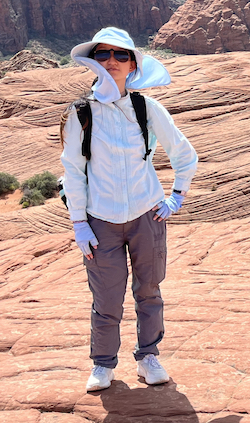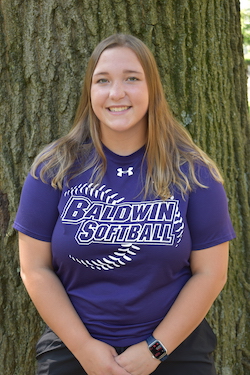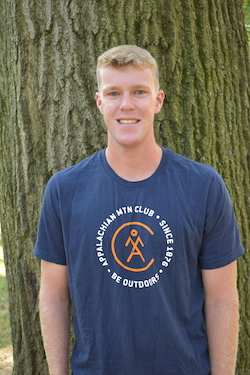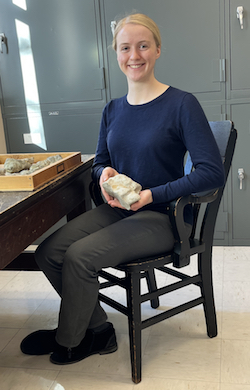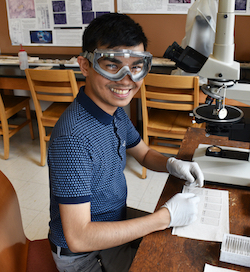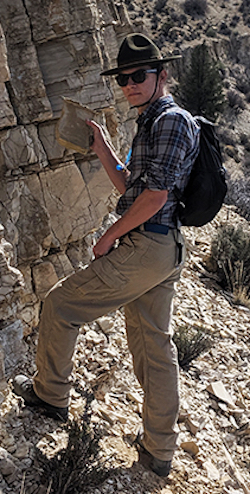Independent Study (I.S.) is a graduation requirement at The College of Wooster. Each student completes three semesters of research supervised and mentored by a Wooster faculty member. In the Earth Sciences Department this often includes field and/or laboratory work in the summer between the junior and senior years as well. My 152 I.S. students are introduced below, along with their projects.
2023-2024
Athena Tharenos (’24) wrote a thesis titled: “On Thinning Ice: A Geoscientific Perspective on the Politics of Resource Exploration in a Changing Arctic”. Athena was a triple major: Anthropology, Chinese Studies, and Environmental Geoscience.
Hudson Davis (’24) wrote a thesis titled: “Examining Late Cretaceous (Maastrichtian) North American dinosaur teeth and their palaeoecological implications in the Hell Creek Formation of Carter County, Montana”. Hudson was a Geology major.
Natalie Tanner (’24) wrote a thesis titled: “The Coevolution of Humankind and Lake Erie – Past, Present, and Future Interactions”. Natalie was a double major: Anthropology and Environmental Geoscience.
Garrett Robertson (’24) wrote a thesis titled: “A Morphological Description of Freshwater Sponge Microfossils and Their Potential as a Paleoenvironmental Proxy When Supplemented with Diatom Biostratigraphy”. Garrett was an Environmental Geoscience major.
2022-2023
Lucie Fiala (’23) studied the stratigraphy, sedimentology and paleontology of the lower portion of the Carmel Formation (Middle Jurassic) in southwestern Utah. She made the case for a new member at the base of the Carmel: the Gunlock Member.
Vicky Wang (’23) collected and analyzed the trace fossils in the Carmel Formation (Middle Jurassic) to test the hypothesis that they would show lower diversity and size than other traces in less restricted parts of the formation. (Surprisingly, they didn’t!)
Richard Torres (’23) did an extensive study of diatoms in lakes of the Upper Midwest, looking at how these floras changed over the last three decades in response to climate change.
Addie Tagg (’23) worked with a nuclear densitometer, studying its design and use in construction. She also performed an experiment to test whether its readings could be thrown off by the use of lawn chemicals. (It wasn’t!)
Ryan Sullivan (’23) created a hydrological and geological profile across a series of private groundwater wells in Shreve, Ohio. He assessed the local hydrology, possible contaminants, and even suggested a potential site for a new water well.
2021-2022
Kate Runciman (’22) examined large trepostome bryozoans from the Cincinnatian Series (Upper Ordovician). She observed how these bryozoans responded in their growth patterns to encrusters and borers while they were alive. She made lots of acetate peels and thin-sections. Her favorite term was “bioclaustration”!
Justine Paul Berina (’22) studied the effects of European-American settlement on a northeast Ohio kettle hole lake using diatom stratigraphy. He established Wooster’s first diatom lab with the skills and knowledge he acquired in this project and through internships. He also became a master microphotographer.
2020-2021
Will Santella (’21) studied the epic stromatolites and thrombolites near the base of the Carmel Formation (Middle Jurassic, Bajocian) exposed in southwestern Utah. This fieldwork in March 2020 was interrupted by the onset of the COVID-19 pandemic, but Will collected enough material for a successful thesis.
2019-2020
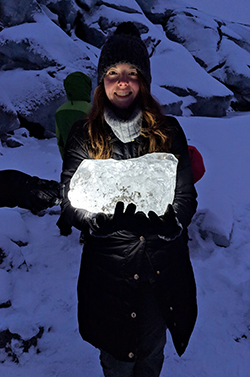 Emily Randall (’20) participated in the summer Keck Consortium project on the Paleocene-Eocene Thermal Maximum in Wyoming. She studied the paleosols and what they can tell us about changing climates. (This great image is from Emily’s earlier excursion to Greenland.)
Emily Randall (’20) participated in the summer Keck Consortium project on the Paleocene-Eocene Thermal Maximum in Wyoming. She studied the paleosols and what they can tell us about changing climates. (This great image is from Emily’s earlier excursion to Greenland.)
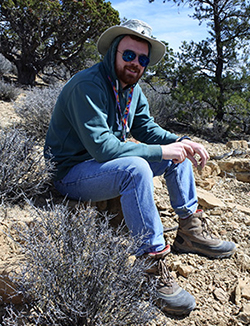
Evan Shadbolt (’20) was part of Team Jurassic Utah 2019 with me, Nick Wiesenberg, Shelley Judge and Anna Cooke (below). Evan studied the bivalves of the Carmel Formation (Middle Jurassic) in southwestern Utah.
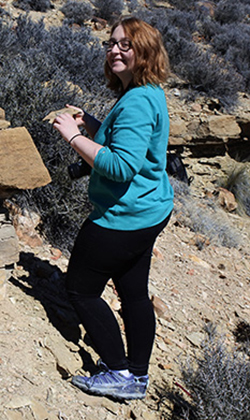 Anna Cooke (’20) was part of Team Jurassic Utah 2019 with me, Nick Wiesenberg, Shelley Judge and Evan Shadbolt (above). Anna studied the ooids of the Carmel Formation (Middle Jurassic) in southwestern Utah.
Anna Cooke (’20) was part of Team Jurassic Utah 2019 with me, Nick Wiesenberg, Shelley Judge and Evan Shadbolt (above). Anna studied the ooids of the Carmel Formation (Middle Jurassic) in southwestern Utah.
2018-2019
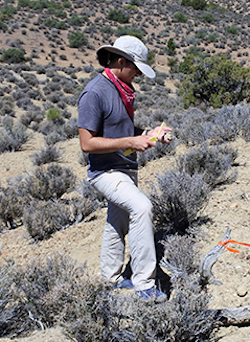 Ethan Killian (’19) was part of Team Jurassic Utah with me and Galen Schwartzberg (below). Ethan studied the ostreoliths (“oyster balls”) of the Carmel Formation (Middle Jurassic) in southwestern Utah.
Ethan Killian (’19) was part of Team Jurassic Utah with me and Galen Schwartzberg (below). Ethan studied the ostreoliths (“oyster balls”) of the Carmel Formation (Middle Jurassic) in southwestern Utah.
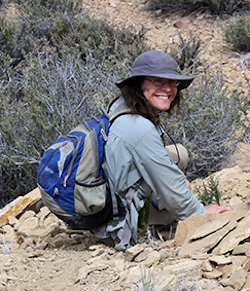 Galen Schwartzberg (’19) was also part of Team Jurassic Utah with me and Ethan Killian (above). Galen studied the sclerobionts (hard substrate dwelling organisms) preserved in the Carmel Formation (Middle Jurassic) of southwestern Utah.
Galen Schwartzberg (’19) was also part of Team Jurassic Utah with me and Ethan Killian (above). Galen studied the sclerobionts (hard substrate dwelling organisms) preserved in the Carmel Formation (Middle Jurassic) of southwestern Utah.
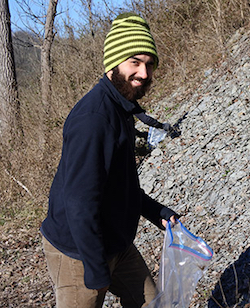
Matthew Shearer (’18) was part of a small team (with me and Luke Kosowatz below) working in the Upper Ordovician of the Cincinnati region. Matthew studied the bryozoans before and after the Richmondian Invasion.
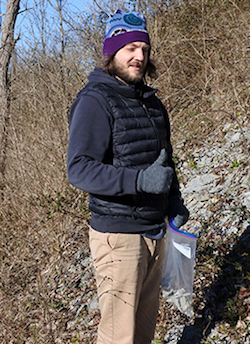
Luke Kosowatz (’17) worked with Matthew Shearer (’18) and me to assess patterns of bioerosion in the Upper Ordovician of the Cincinnati area associated with the Richmondian Invasion.
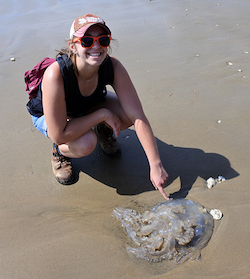
Macy Conrad (’18) traveled with me to southwestern France where we worked with Paul Taylor (Natural History Museum, London) to study encrusting bryozoans on oysters from three formations in the Type Campanian.

Brandon Bell (’18) was a double major in History and Geology. His study was an examination of the early days of seismology, using the 1906 San Francisco earthquake to look at both the development of the science and the complex interactions of Japanese and American geologists as they debated seismological theory.
2016-2017
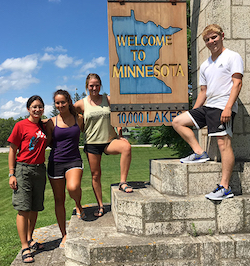
Four of my Independent Study students this year were part of Team Minnesota. We studied the Decorah Formation (Upper Ordovician) with the expert assistance of Andrew Retzler (’11), the Paleozoic Geologist of Minnesota, and four excellent Lab Technician Nick Wiesenberg. Team Minnesota had several integrated projects including paleoecology, biostratigraphy, and systematic analysis. The students are listed individually below.
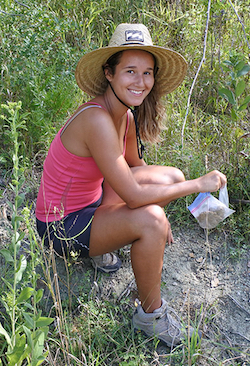
Nikki Bell (’17) assessed the brachiopods of the Decorah Formation exposed in southern Minnesota and northern Iowa.
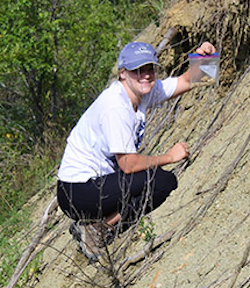
Rachel Wetzel (’17) studied the trepostome bryozoan Prasopora in the Decorah Formation of southern Minnesota and northern Iowa.
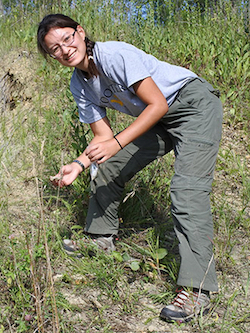
Etienne Fang (’17) examined Ordovician “iron ooids” of the Decorah Formation in southern Minnesota as part of her I.S. work.
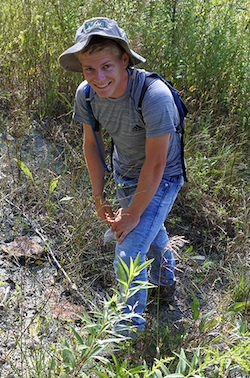
Dean Thomas (’17) studied conodonts from the dissolved out of limestones of the Deborah Formation.
 Cassidy Jester (’17) traveled to southern England to collect and examine sclerobionts (hard substrate dwellers) associated with iron oxide oncoids (“snuffboxes”) in the Middle Jurassic Inferior Oolite exposed in Dorset. We were assisted in the field by long-time friend Tim Palmer and a new friend Bob Chandler.
Cassidy Jester (’17) traveled to southern England to collect and examine sclerobionts (hard substrate dwellers) associated with iron oxide oncoids (“snuffboxes”) in the Middle Jurassic Inferior Oolite exposed in Dorset. We were assisted in the field by long-time friend Tim Palmer and a new friend Bob Chandler.
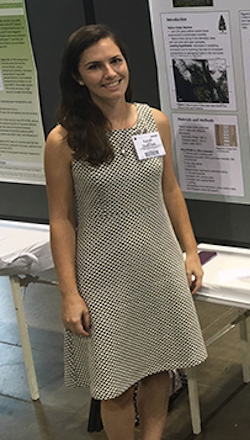
Sarah McGrath (’17), did her project research at Wood’s Hole Oceanographic Institution where she had an internship with Delia Oppo to study tropical Atlantic currents during the last glacial interval using foraminiferans.
2015-2016
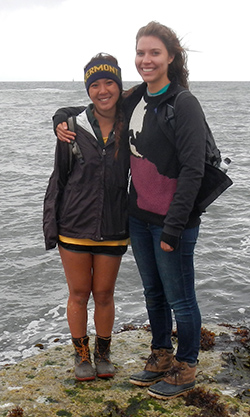 Mae Kemsley (left) and Meredith Mann (right) did their Senior Independent Study research on the coast of Yorkshire in the summer of 2015. Mae worked with belemnites found in the Speeton Clay (Cretaceous), sorting out their paleoecology with carbon and oxygen isotopes. Meredith studied a Jurassic section at Filey Brigg, the tip of which they are standing on here. She collected rocks and fossils from the Passage Beds to see how the communities changed with sea level fluctuations. She also did a bit of isotope work.
Mae Kemsley (left) and Meredith Mann (right) did their Senior Independent Study research on the coast of Yorkshire in the summer of 2015. Mae worked with belemnites found in the Speeton Clay (Cretaceous), sorting out their paleoecology with carbon and oxygen isotopes. Meredith studied a Jurassic section at Filey Brigg, the tip of which they are standing on here. She collected rocks and fossils from the Passage Beds to see how the communities changed with sea level fluctuations. She also did a bit of isotope work.
2014-2015
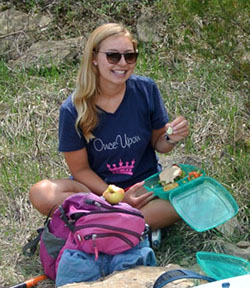 Sarah Bender spent a lot of time underwater for her Senior Independent Study research. She worked on a Keck Geology Consortium project in Belize doing lots of diving on spectacular coral reefs. Her title: “Grazer Dynamics on a Relict Acroporid Patch Reef System and Their Implications for the Carbonate Budget at Coral Gardens, Belize”. She also had an earlier research experience in The Bahamas.
Sarah Bender spent a lot of time underwater for her Senior Independent Study research. She worked on a Keck Geology Consortium project in Belize doing lots of diving on spectacular coral reefs. Her title: “Grazer Dynamics on a Relict Acroporid Patch Reef System and Their Implications for the Carbonate Budget at Coral Gardens, Belize”. She also had an earlier research experience in The Bahamas.
 Coleman Fitch did his Senior Independent Study work in the beautiful Cincinnatian Group exposed around the tri-state area of Indian, Kentucky and Ohio. His title: “Macroborings and Their Relationship to Encrusting Bryozoans on Brachiopods and Bivalves from the Upper Ordovician of the Cincinnatian Group“.
Coleman Fitch did his Senior Independent Study work in the beautiful Cincinnatian Group exposed around the tri-state area of Indian, Kentucky and Ohio. His title: “Macroborings and Their Relationship to Encrusting Bryozoans on Brachiopods and Bivalves from the Upper Ordovician of the Cincinnatian Group“.
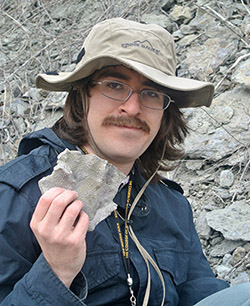 William Harrison also centered his Senior Independent Study project in the Cincinnatian Group, with a fascinating summer experience doing experimental bryozoology at a marine lab in Panama. His title: “The Symbiosis Between Bioclaustrated Organisms and Their Host Bryozoans in the Late Ordovician“.
William Harrison also centered his Senior Independent Study project in the Cincinnatian Group, with a fascinating summer experience doing experimental bryozoology at a marine lab in Panama. His title: “The Symbiosis Between Bioclaustrated Organisms and Their Host Bryozoans in the Late Ordovician“.
 Ian Tulungen worked for his Senior Independent Study on a magnificent collection of platyceratid snails and their encrusters from the Silurian of Indiana. His title: “Effects of a Growing Substrate on Secondarily Tiered Cornulitids of the Waldron Shale: Middle Silurian (Wenlockian) of Indiana“.
Ian Tulungen worked for his Senior Independent Study on a magnificent collection of platyceratid snails and their encrusters from the Silurian of Indiana. His title: “Effects of a Growing Substrate on Secondarily Tiered Cornulitids of the Waldron Shale: Middle Silurian (Wenlockian) of Indiana“.
2013-2014
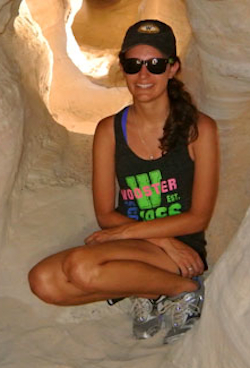 Steph Bosch was a member of Team Israel 2013. Her project was finding and describing the first bryozoans from the tropical Jurassic, working in the beautiful Makhtesh Gadol of southern Israel. The title of her Independent Study thesis is: “First bryozoan fauna described from the Jurassic tropics: Specimens from the Matmor Formation (Middle Jurassic, Upper Callovian) in southern Israel“. Her work, which includes descriptions of new bryozoan species, will soon be published in a journal article.
Steph Bosch was a member of Team Israel 2013. Her project was finding and describing the first bryozoans from the tropical Jurassic, working in the beautiful Makhtesh Gadol of southern Israel. The title of her Independent Study thesis is: “First bryozoan fauna described from the Jurassic tropics: Specimens from the Matmor Formation (Middle Jurassic, Upper Callovian) in southern Israel“. Her work, which includes descriptions of new bryozoan species, will soon be published in a journal article.
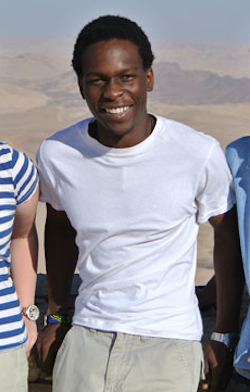 Oscar Mmari was also on Team Israel 2013. He is the first Wooster student to work on the extensive phosphatic units exposed south of Makhtesh Gadol, and the first to do some structural geology. His Independent Study thesis title is: “Syndepositional faulting, shallowing and intraformational conglomerates in the Mishash Formation (Upper Cretaceous, Campanian) at Wadi Hawarim, southern Israel“.
Oscar Mmari was also on Team Israel 2013. He is the first Wooster student to work on the extensive phosphatic units exposed south of Makhtesh Gadol, and the first to do some structural geology. His Independent Study thesis title is: “Syndepositional faulting, shallowing and intraformational conglomerates in the Mishash Formation (Upper Cretaceous, Campanian) at Wadi Hawarim, southern Israel“.
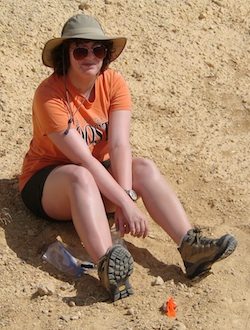 Lizzie Reinthal was the third member of Team Israel 2013. Like Steph, she worked in the Jurassic of Makhtesh Gadol, in her case examining the taphonomy of crinoids. Her I.S. title: “Taphonomic feedback and facilitated succession in a Middle Jurassic shallow marine crinoid community (Matmor Formation, southern Israel)“. Part of her work, including a description of a new crinoid species, will be published in an upcoming issue of the Journal of Paleontology.
Lizzie Reinthal was the third member of Team Israel 2013. Like Steph, she worked in the Jurassic of Makhtesh Gadol, in her case examining the taphonomy of crinoids. Her I.S. title: “Taphonomic feedback and facilitated succession in a Middle Jurassic shallow marine crinoid community (Matmor Formation, southern Israel)“. Part of her work, including a description of a new crinoid species, will be published in an upcoming issue of the Journal of Paleontology.
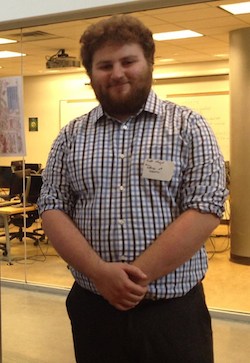 Scott Kugel was part of a Keck Geology Consortium team for his thesis work, so I have no images of him in the field. His I.S. is titled: “Discerning extreme weather events in the Connecticut River system through the study of sediments in upland dams and flood control reservoirs of western Massachusetts and southwestern Vermont“.
Scott Kugel was part of a Keck Geology Consortium team for his thesis work, so I have no images of him in the field. His I.S. is titled: “Discerning extreme weather events in the Connecticut River system through the study of sediments in upland dams and flood control reservoirs of western Massachusetts and southwestern Vermont“.
2012-2013
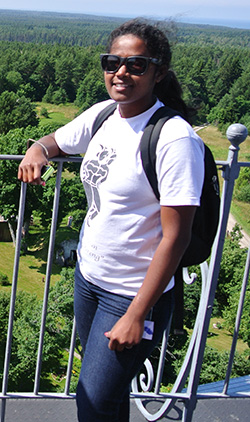 Richa Ekka did her Independent Study fieldwork in Estonia, mostly on the western island of Saaremaa. Her I.S. title is: “Stratigraphy and paleoenvironments of the Soeginina Beds (Paadla Formation, Lower Ludlow, Upper Silurian) on Saaremaa Island, Estonia“. She specialized in hypersaline depositional environments and shallow-water dolomites. The high point of her fieldwork was finding a complete eurypterid.
Richa Ekka did her Independent Study fieldwork in Estonia, mostly on the western island of Saaremaa. Her I.S. title is: “Stratigraphy and paleoenvironments of the Soeginina Beds (Paadla Formation, Lower Ludlow, Upper Silurian) on Saaremaa Island, Estonia“. She specialized in hypersaline depositional environments and shallow-water dolomites. The high point of her fieldwork was finding a complete eurypterid.
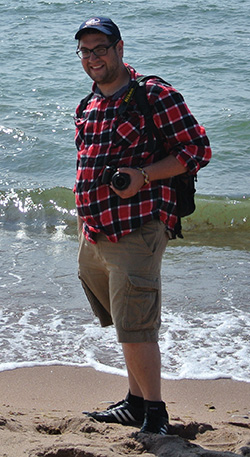 Jonah Novek also worked in Estonia, primarily on the island of Hiiumaa. He especially enjoyed shallow marine invertebrate communities of the Silurian. His I.S. title: “Analysis of a Rhuddanian (Llandovery, Lower Silurian) sclerobiont community in the Hilliste Formation on Hiiumaa Island, Estonia: a hard substrate-dwelling recovery fauna“. Jonah’s brachiopod-rich communities are among the earliest in the Silurian — soon after a major mass extinction.
Jonah Novek also worked in Estonia, primarily on the island of Hiiumaa. He especially enjoyed shallow marine invertebrate communities of the Silurian. His I.S. title: “Analysis of a Rhuddanian (Llandovery, Lower Silurian) sclerobiont community in the Hilliste Formation on Hiiumaa Island, Estonia: a hard substrate-dwelling recovery fauna“. Jonah’s brachiopod-rich communities are among the earliest in the Silurian — soon after a major mass extinction.
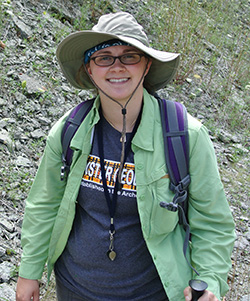 Kit Price‘s Independent Study project involved sclerobionts from the Upper Ordovician of the Cincinnati region. The title of her I.S. was: “Upside-down and inside-out: Cryptic skeletobiont communities from the Late Ordovician of Ohio, Indiana, and Kentucky“. She carefully mapped out the growth of sclerobionts such as bryozoans and cornulitids that grew inside mollusk shells.
Kit Price‘s Independent Study project involved sclerobionts from the Upper Ordovician of the Cincinnati region. The title of her I.S. was: “Upside-down and inside-out: Cryptic skeletobiont communities from the Late Ordovician of Ohio, Indiana, and Kentucky“. She carefully mapped out the growth of sclerobionts such as bryozoans and cornulitids that grew inside mollusk shells.
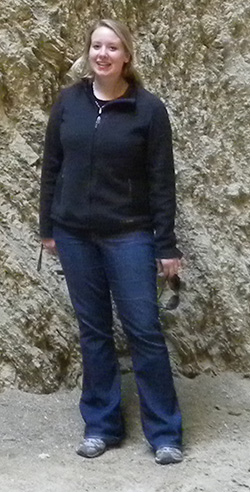 Melissa Torma did her fieldwork in southern Israel in the middle of the Negev during the 2012 Spring Break. Her I.S. title: “Patchiness and ecological structure in a Middle Jurassic equatorial crinoid-brachiopod community (Matmor Formation, Callovian, southern Israel)“. Her worked helped sort out the brachiopods of this diverse fossil fauna for a later paleoecological analysis.
Melissa Torma did her fieldwork in southern Israel in the middle of the Negev during the 2012 Spring Break. Her I.S. title: “Patchiness and ecological structure in a Middle Jurassic equatorial crinoid-brachiopod community (Matmor Formation, Callovian, southern Israel)“. Her worked helped sort out the brachiopods of this diverse fossil fauna for a later paleoecological analysis.
2011-2012
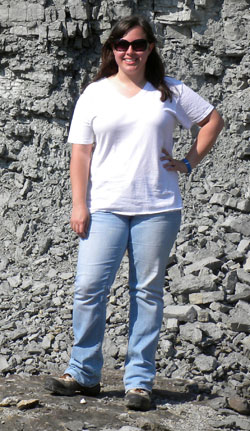 Rachel Matt‘s I.S. project was entitled: “Paleoecology of the Hilliste Formation (Lower Silurian, Llandovery, Rhuddanian) Hiiumaa Island, Estonia: An example of a shallow marine recovery fauna.” She traveled with me and Nick Fedorchuk (below) to Estonia in the summer of 2011. She specialized in the invertebrate fossils (primarily brachiopods, corals and stromatoporoids) found in the lowest Silurian exposed on the little western Estonian island of Hiiumaa. You can see Rachel and Nick all cleaned up for their GSA poster presentations on the Wooster Geologists blog.
Rachel Matt‘s I.S. project was entitled: “Paleoecology of the Hilliste Formation (Lower Silurian, Llandovery, Rhuddanian) Hiiumaa Island, Estonia: An example of a shallow marine recovery fauna.” She traveled with me and Nick Fedorchuk (below) to Estonia in the summer of 2011. She specialized in the invertebrate fossils (primarily brachiopods, corals and stromatoporoids) found in the lowest Silurian exposed on the little western Estonian island of Hiiumaa. You can see Rachel and Nick all cleaned up for their GSA poster presentations on the Wooster Geologists blog.
 Nick Fedorchuk‘s I.S. project was: “Stratigraphy and paleoecology at the Wenlock/Ludlow Boundary on Saaremaa Island, Estonia.” He worked on the larger western Estonian island of Saaremaa doing a centimeter-by-centimeter analysis of a critical boundary section. Nick’s work required much detailed petrography of limestones and dolomites with thin-sections. Our essential Estonian colleague and friend on these projects was Olev Vinn of the University of Tartu.
Nick Fedorchuk‘s I.S. project was: “Stratigraphy and paleoecology at the Wenlock/Ludlow Boundary on Saaremaa Island, Estonia.” He worked on the larger western Estonian island of Saaremaa doing a centimeter-by-centimeter analysis of a critical boundary section. Nick’s work required much detailed petrography of limestones and dolomites with thin-sections. Our essential Estonian colleague and friend on these projects was Olev Vinn of the University of Tartu.
2010-2011
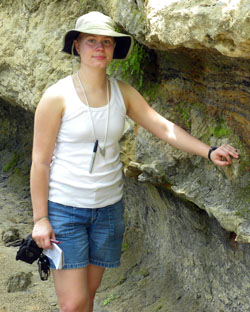 Megan Innis traveled with me to Alabama and Mississippi in the summer of 2010 where we met our friend Paul Taylor (Natural History Museum, London) and Caroline Sogot (Cambridge University) for fieldwork at the Cretaceous-Paleogene boundary. We found sclerobionts preserved on shell surfaces before and after the mass extinction which became the basis for Megan’s work and a Geological Society of America presentation. Megan showed that some borings, such as those by sponges, were virtually unaffected by the extinction event. Others (notably bivalve borings) changed distribution dramatically.
Megan Innis traveled with me to Alabama and Mississippi in the summer of 2010 where we met our friend Paul Taylor (Natural History Museum, London) and Caroline Sogot (Cambridge University) for fieldwork at the Cretaceous-Paleogene boundary. We found sclerobionts preserved on shell surfaces before and after the mass extinction which became the basis for Megan’s work and a Geological Society of America presentation. Megan showed that some borings, such as those by sponges, were virtually unaffected by the extinction event. Others (notably bivalve borings) changed distribution dramatically.
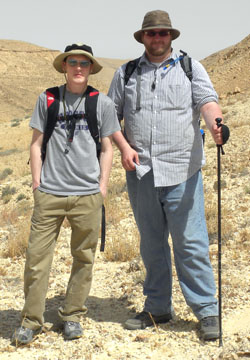 Andrew Retzler and Micah Risacher went with me to Israel in the summer of 2010 to study Upper Cretaceous fossils and rocks in the Negev Highlands. Andrew concentrated on shark teeth in the Menuha Formation, and Micah worked on the invertebrate fossils in the Zihor Formation. Their work also resulted in two GSA presentations (Micah, Andrew), and Andrew and I have recently had a manuscript on the fossil shark teeth accepted in Cretaceous Research. Our excellent Israeli colleagues and friends are Yoav Avni and Amihai Sneh of the Geological Survey of Israel.
Andrew Retzler and Micah Risacher went with me to Israel in the summer of 2010 to study Upper Cretaceous fossils and rocks in the Negev Highlands. Andrew concentrated on shark teeth in the Menuha Formation, and Micah worked on the invertebrate fossils in the Zihor Formation. Their work also resulted in two GSA presentations (Micah, Andrew), and Andrew and I have recently had a manuscript on the fossil shark teeth accepted in Cretaceous Research. Our excellent Israeli colleagues and friends are Yoav Avni and Amihai Sneh of the Geological Survey of Israel.
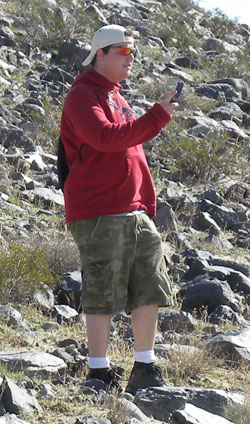 Michael Snader closely studied a new core drilled through the Black Hand Sandstone (Lower Carboniferous) in northeastern Ohio to sort out depositional facies and history. A complete core like this is rare for this interval, so his work has considerable significance.
Michael Snader closely studied a new core drilled through the Black Hand Sandstone (Lower Carboniferous) in northeastern Ohio to sort out depositional facies and history. A complete core like this is rare for this interval, so his work has considerable significance.
2009-2010
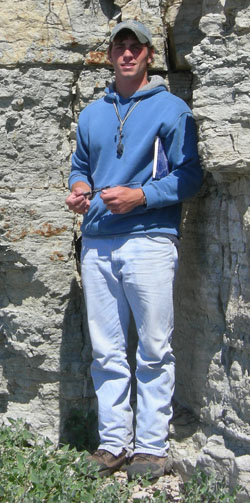 Rob McConnell and Palmer Shonk studied Silurian rocks and fossils with me and our colleague Bill Ausich (Ohio State University) on the beautiful island of Saaremaa in Estonia. Rob did a paleoenvironmental analysis of the Jaani Formation (Wenlock), concentrating on the Mustjala and Ninase members at three sites along the northern Saaremaa coast: Liiva Cliff, Suuriku Cliff, and Panga Cliff.
Rob McConnell and Palmer Shonk studied Silurian rocks and fossils with me and our colleague Bill Ausich (Ohio State University) on the beautiful island of Saaremaa in Estonia. Rob did a paleoenvironmental analysis of the Jaani Formation (Wenlock), concentrating on the Mustjala and Ninase members at three sites along the northern Saaremaa coast: Liiva Cliff, Suuriku Cliff, and Panga Cliff.
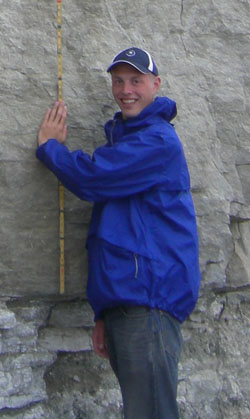 Palmer worked on a paleoenvironmental reconstruction of the Äigu Beds (Pridoli) in the Kaugatuma formation on the Sõrve Peninsula of southwestern Saaremaa. He described a complex crinoid forest in a high-energy limestone sequence.
Palmer worked on a paleoenvironmental reconstruction of the Äigu Beds (Pridoli) in the Kaugatuma formation on the Sõrve Peninsula of southwestern Saaremaa. He described a complex crinoid forest in a high-energy limestone sequence.
2008-2009
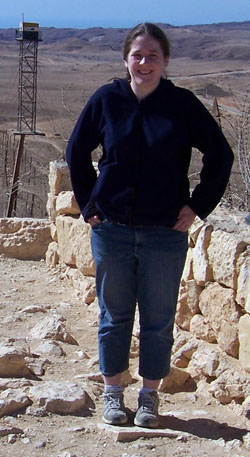 Elyssa Belding (now Elyssa Krivicich) traveled with me to the Negev Desert of southern Israel to continue a long-term project on Jurassic stratigraphy and paleoecology. Among many accomplishments, she helped put together the first complete stratigraphic column of the Matmor Formation as part of her thesis.
Elyssa Belding (now Elyssa Krivicich) traveled with me to the Negev Desert of southern Israel to continue a long-term project on Jurassic stratigraphy and paleoecology. Among many accomplishments, she helped put together the first complete stratigraphic column of the Matmor Formation as part of her thesis.
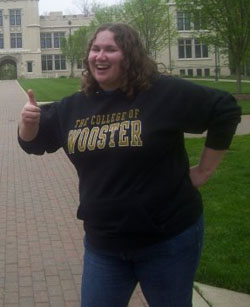 Heather Hunt was the first student in 25 years to return to the Logan Formation (Lower Carboniferous) exposed in Wooster to assess its paleoecological and sedimentological history. She took advantage of a new series of roadcuts and found a wonderful array of fossils, most of which would be familiar to generations of Wooster geology students who visited the “Little Arizona” outcrop (which is now long gone).
Heather Hunt was the first student in 25 years to return to the Logan Formation (Lower Carboniferous) exposed in Wooster to assess its paleoecological and sedimentological history. She took advantage of a new series of roadcuts and found a wonderful array of fossils, most of which would be familiar to generations of Wooster geology students who visited the “Little Arizona” outcrop (which is now long gone).
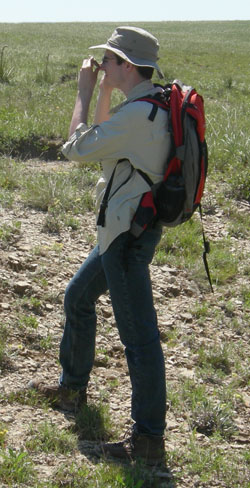 John Sime went with me and our colleague Paul Taylor (Natural History Museum, London) to investigate the taphonomy of sclerobiont communities in Late Cretaceous baculitid conchs preserved in the Pierre Shale of South Dakota, Wyoming and Montana. We found very interesting preservational patterns which may be related to the unusual water chemistry of the Western Interior Seaway at the time.
John Sime went with me and our colleague Paul Taylor (Natural History Museum, London) to investigate the taphonomy of sclerobiont communities in Late Cretaceous baculitid conchs preserved in the Pierre Shale of South Dakota, Wyoming and Montana. We found very interesting preservational patterns which may be related to the unusual water chemistry of the Western Interior Seaway at the time.
2007-2008
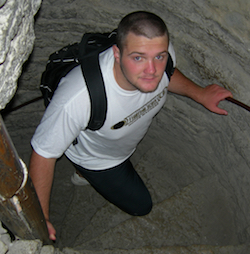
Andrew Milligan (’08) collected Ordovician cystoids with me in northern Estonia. We were hosted by my friend Olev Vinn at the University of Tartu. These fossils are found in an unusual fossiliferous oil shale which holds many paleontological and sedimentological puzzles.
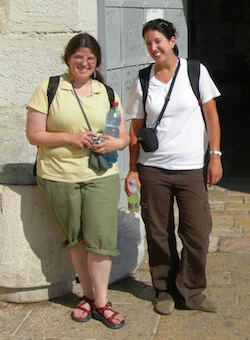
Sophie Lehmann (’08, left) and Meredith Sharpe (’08, right) traveled with me to the Negev Desert of southern Israel to continue a long-term project on Jurassic stratigraphy and paleoecology. They worked with our colleague Yoav Avni of the Geological Survey of Israel in Makhtesh Gadol on the Matmor Formation. Sophie measured and sampled the basal units of the Matmor and Meredith did the same with the top.
2006-2007
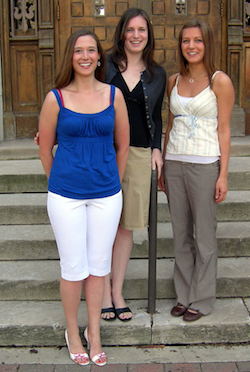
Cordy Dennison-Budak (’07) completed her I.S. study on bioerosion of Late Ordovician brachiopods in the Cincinnati region, focusing primarily on unusual “half borings” preserved on the surfaces of strophomenids. She is on the far left with Else Zavar (’07) and Emiliann Griffin (’07).

Elyse Zavar (’07) finished her project on the Middle-Late Jurassic (Callovian-Oxfordian) Transition in southern Poland, discovering a diverse cryptic encrusting community in these boundary rocks.
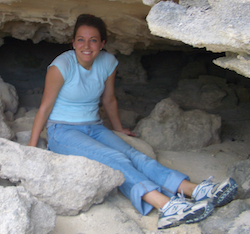
Emiliann Griffin (’07) worked on an Eemian (Late Pleistocene) sea level event recorded on Great Inagua and San Salvador Islands in The Bahamas. Emiliann concentrated on the ecological succession of coral and molluscan communities in exposed Eemian reefs. Our colleagues were Al Curran of Smith College and Bill Thompson of Woods Hole Oceanographic Institution.
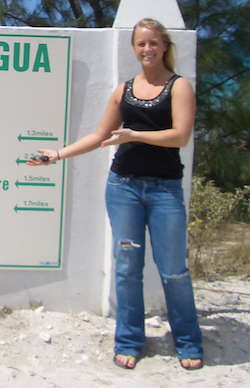
Ann Steward (’07) also worked on the Eemian (Late Pleistocene) sea level event recorded on Great Inagua and San Salvador Islands in The Bahamas. Ann helped sort out the complicated geochronology of this event with U/Th dating of coral samples.
2005-2006

Jeff Bowen (’06) worked on a very shallow Middle Jurassic coral and sponge community exposed in Makhtesh Gadol in the central Negev of southern Israel. We were assisted by our friend Yoav Avni of the Geological Survey of Israel.
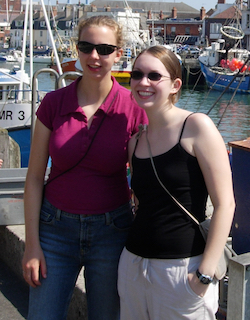
Erica Clites (’06, left) and Monica Umstead (’06, right) did their I.S. fieldwork in Dorset, southern England, on Jurassic communities. We were assisted by our friend Tim Palmer, University of Wales, Aberystwyth.
2004-2005

Drew Feucht (’05) did fieldwork on Long Island, The Bahamas, with me and Al Curran of Smith College. During the summer we described the stratigraphy and paleoecology of the transition between the Pleistocene and Holocene on the island.
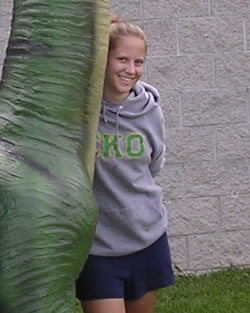
Suzanne Boyenton (’05) studied the carbonate petrography and paleoenvironments of Ordovician limestones in central Tennessee. She and I were assisted by Jeff Bowen (’06) and Monica Umstead (’06) in our summer fieldwork near Nashville.
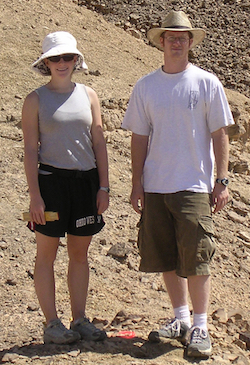
Allison Mione (’05, left) and Kevin Wolfe (’05, right) did fieldwork with me in the Negev Desert of southern Israel. We were supported by the Geological Survey of Israel, especially Amihai Sneh and Yoav Avni. Allison described and interpreted an unusual Triassic bivalve from Makhtesh Ramon, and Kevin worked on a Jurassic rocky shore the team found in Makhtesh Qatan.
2003-2004
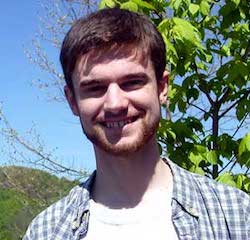
Andy Shields (’04) and Aaron House (’04, below) were part of a project to sort out the paleoecology, taxonomy, and distribution of Ordovician borings in the Upper Mississippi River Valley. They spent part of the summer in Minnesota, Iowa, Indiana, northern Kentucky, and southern Ohio collecting bored substrates. Aaron concentrated on the borings in the bryozoan Prasopora, and Andy looked at the dynamics of the “worm” boring Trypanites.

I wish I had a field photo of Aaron House (’04)! We’ll use his much later LinkedIn image. See details above.
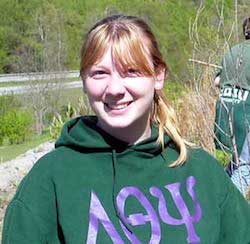
Jessica Hiznay (’04) studied the distribution of a Pennsylvanian limestone unit in an underground mine in northeastern Ohio. She and Mark were assisted by the chief geologist of the mine, Tim Miller. Jessica’s goal was to determine the causes of “bad roof” in the mine, which she did.
2002-2003
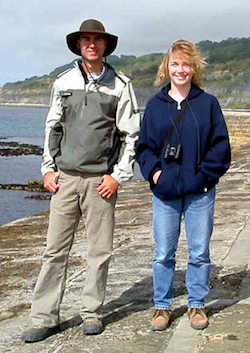
Katherine Nicholson (’03, right) traveled with me to southern England in May 2002 to study the fossil fauna of the Portland Limestone (Late Jurassic). She sorted out the dynamics of a cryptic encrusting community inside mollusk shells in this classic unit. Rich Poole (’03, left) assisted us in the field as he added data and observations to his I.S. project on creationist geology, which was part of his double major with Religious Studies.
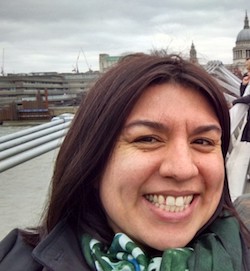
Kathy Bremar (’03) was part of the 2002 Keck Australia project. She analyzed the sedimentology and stratigraphy of a Pleistocene conglomeratic unit in southeastern Australia. This is a great photo she took much later!
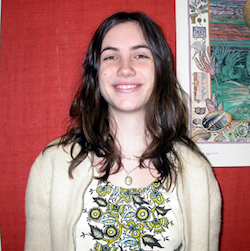
Jessica Conroy (’03) was a participant in the 2002 Keck Ireland program. She completed a detailed analysis and interpretation of the fossils and sediments in a core from an Irish bog. She concentrated on the population and ecophenotypic dynamics of freshwater mollusks.
2001-2002
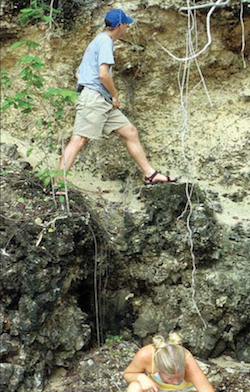
Sara Austin (’02, lower), Jerome Hall (’02, upper) and Andrea Martin (’02, below) traveled with me to Jamaica to study the Falmouth Formation (Eemian, Last Interglacial) as part of a continuing program to document Late Pleistocene climate fluctuations as recorded in coral reef development. These students were also featured in a Science article on the value of undergraduate research (August 31, 2001, issue).
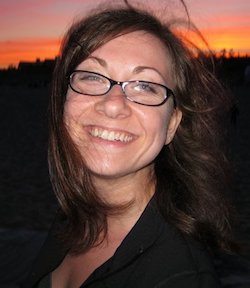
Here is Andrea Martin (’02, see details above). I don’t have a field photo of her, so this excellent image is taken from her later Facebook page.
2000-2001
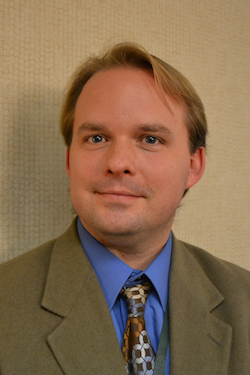
Russ Kohrs (’01; a more recent image, but he did look just like this!) His topic was bioimmuration and epibiont succession in the Whitewater Formation (Cincinnatian Series, Upper Ordovician), of eastern Indiana
1982-2000
Babcock, Penelope J.
Examination of the creation/evolution controversy
1982
McCormick, Michael
Life habits and paleoecology of trilobites
1982
Norrish, Winston A.
Petrographic analysis of Diplocraterion ichnofossils from Cincinnatian series strata (Upper Ordovician) in Cincinnati, Ohio
1982
Quinn, Darrin
Oil shale: the geologic setting and geochemical development of Eocene Green River Formation in Utah, Colorado, and Wyoming
1982
Szentendrey, Charles E.
Development of synthetic fuels from coal
1982
Kozar, Michael
Petrography, depositional environments and paleotectonics of the Lower Bird Spring Formation (Morrowan) Clark County, Nevada
1983
Leach, Brad
Paleocommunities from the Logan Formation (Lower Mississippian) in Wayne County, Ohio
1983
Tissue, Eric C.
Triticites paleoecology in a Lower Missourian (Upper Pennsylvanian) portion of Bird Spring Formation, southern Nevada
1983
Totten, William B.
Microfacies changes in the Salem Limestone (Mississippian) of south-central Indiana: a petrographic study
1983
Widman, Sally
Conodont analysis: biostratigraphy and paleoecologic interpretation of lower Bird Spring Formation, southern Nevada
1983
Willard, James S.
Siliciclastic unit in carbonate sequence, Lower Missourian Bird Spring Formation, Clark County, Nevada
1983
Genger, David L. II
Critical analysis of previous works on conodont biostratigraphy in northeast Ohio
1984
LaMonte, Robert C.
Functional morphologic study of the Lower Mississippian bivalve Aviculopecten winchelli Meek 1875
1984
LeVan, Kenneth Ben
Environmental analysis of the Upper Bird Spring Formation and overlying Permian redbeds in Clark County, Nevada
1984
Pearson, Carol J.
Paleoecological study of the Grant Lake Limestone (Upper Ordovician: Cincinnatian) in Manchester, Adams County, Ohio
1984
Ulrich, James L.
Conodont analysis and sedimentary petrography of a portion of Bird Spring Formation (Morrowan/Atokan), Clark County, Nevada
1984
Yoder, Jennifer
Paleoecology of two Permian brachiopod faunas in the Glass Mountains, western Texas
1984
Miller, Jonathan
Paleoenvironmental and paleoecological analysis of the Chambless Limestone (Lower Cambrian), southeast California
1985
Neagoy, Nancy J.
Paleoenvironmental analysis of the Middle Grant Lake Limestone (Upper Ordovician), southern Ohio
1985
Siewers, Frederick D.
Paleoenvironmental analysis of the (Lower Cambrian) Latham Shale southeastern California
1985
McClure, Doug
Paleoecology of a Mississippian prodeltaic community (Cuyahoga Formation) northeast Ohio
1986
Bodenbender, Brian
Paleoecologic analysis of an Upper Ordovician hardground fossil community from Dillsboro, Indiana
1987
Piscetta, Robert A.
Systematic study of Palaeoneilo sulcatina (Bivalvia)
1987
Raker, John M.
Paleoecological analysis of Wooster shale member (Lower Mississippian) in northeast Ohio
1987
Umstott, Roger A.
Paleoecological study of Tornquista (Brachiopoda: Chonetacea), Cuyahoga Formation (Mississippian) of northeast Ohio
1987
Ansara, Sam
Systematic/paleontological analysis of rugose corals of the Columbus Limestone (Devonian, Ohio)
1988
Burris, Cynthia
Functional morphology & paleoecology of the Hippocardia cunea (Devonian, Rostrochonchia)
1988
DeReamer, Timothy
Facies control of conodont distribution in the Columbus Limestone (Devonian, Ohio)
1988
Neal, Lynn A.
Distribution and ecology of marine pebble and cobble communities on San Salvador Island, Bahamas
1988
Park, Lisa E.
New interpretations of arthropod-bearing nodules from the Miocene of southern California
1988
Reierson, Carolyn
Diagenetic origin, depositional environmental and stratigraphy of encrusted limestone cobbles in the Cincinnatian series (Upper Ordovician), northern Kentucky
1988
Lahm, Terry
Marine borings of carbonate hard substrates on San Salvador Island, Bahamas
1989
Nadaraju, Genga Thavi
Borings associated with a Miocene coral reef complex, Fortuna basin, southeastern Spain
1990
Simonds, Jay T.
Paleoecology of stromatoporoids and tabulate corals of the LaVielle Formation, Silurian, Southern Gaspé Peninsula, Quebec, Canada
1990
Sommer, Robyn
Paleoenvironment of Bouleaux member: the West Point Formation (Silurian), Gaspé Peninsula, Quebec
1990
Avery, William H. III
Upper Ordovician rugose coral epizoans from the Cincinnati Arch region
1991
Buckley, Sean M.
Paleoecology and systematics of brachiopods found in Kanosh shale (Early Ordovician, Upper Arenig) in Millard County, west-central Utah
1991
Finton, Christopher D.
Paleoenvironmental and biostratigraphic study of hardground-bearing Kanosh Shale (Ordovician, Late Arenig) in west-central Utah
1991
Kaufman, Lewis E.
Rapid sea-floor calcite precipitation and development of hardgrounds in Kanosh Shale (Ordovician, Upper Arenig) in Millard County, west-central Utah
1991
Noble, Robinson S.
Paleoenvironmental and paleoecological analyses of Pleistocene lagoonal mollusk-rich facies, San Salvador, Bahamas
1991
St. John, James
Cincinnatian (Upper Ordovician) hardgrounds and hardground communities from Caesar Creek Reservoir, Warren County, Ohio
1991
Barton, Andrew C.
Paleoenvironmental/stratigraphic study of Middle Ordovician Trenton Group of central New York state
1992
Kear, Andrew R.
Quantitative analysis and petrographic comparison of four Middle Jurassic hardgrounds from Anglo-Paris Basin
1992
Lewellen, Anne R.
Paleoecology/Astogeny of Prasopora falesi in Kings Falls Sugar River Formations, Trenton Group, Middle Ordovician
1992
White, James V.B.
Diagenesis of Rockland Kings Falls and Sugar River Formations, Trenton Group, Middle Ordovician, Central New York
1992
Brown, Stacy D.
Evidence for the Existence of Pennsylvanian Xenacanth Sharks in Marine Environments
1993
Hohman, Julia L.
Progression of Bioerosion & Encrustation of the Queen Conch Shell (Strombus gigas), San Salvador, Bahamas
1993
Schopf, Carl
Functional Morphology of the Distal Humerus of Australopithecus afarensis
1993
Burgy, Tara
Aragonite dissolution and calcite precipitation on Ordovician seafloors
1994
Johnson, Christopher
Paleoecology and Systematics of the Inarticulate Brachiopod Petrocrania scabiosa in the Grant Lake Formation of Maysville, Kentucky
1994
Smail, Steve
Ichnological/paleoenvironmental analysis of Middle Jurassic Carmel Formation, southwestern Utah
1994
Kinney, Paul D.
The Boring Trypanites in the Cincinnati Series (Upper Ordovician) of Southwest Ohio, Southeast Indiana, and Northern Kentucky
1995
Miller, Gary A., Jr.
The Heliolitid Coral Protaraea in the Ordovician of Ohio, Indiana, and Kentucky
1995
Bedi, Ravi
Environmental Distribution of Conodonts in the Upper Cincinnatian Group (Upper Ordovician of Ohio)
1996
Bouder, Richard
Provenance and Depositional Environment of the Colombacci Formation (Miocene) in the Northern Apennines, Umbria-Marche Region, Italy
1996
Masters, Robert
36Cl Groundwater Travel Time Age Corrections Using a Step-Leaching Method at Yucca Mountain, Nye County, Nevada
1996
Ozanne, Colin
Ostreoliths of the Carmel Formation (Middle Jurassic, Southwest Utah): Their Development and Significance as Paleoenvironmental Indicators
1996
Buddenhagen, Andy
Paleoenvironmental Analysis of an Overhanging Hardground in the Middle Jurassic Carmel Formation, Southwestern Utah, USA
1997
Dornbos, Steve
Paleoecology and Lazarus Taxa of the Pliocene Nicosia Formation, Central Mesaoria Plain, Cyprus
1997
Elmore, Jesse
Using Fluid Inclusions to Determine the Origin of Calcite Cements in Nautiloid Fossils of the Kanosh Shale, Ordovician of Western Utah
1997
Fernandez, Rowell
Depositional Environments and Provenance of the Dakota Formation (Cretaceous), Southwest Utah
1997
Hubbard, William J.
Analysis of a Mastodon Trackway Located Near Saline, Michigan, and Its Implications for the Systematic Hunting of Mastodon By Paleo-Indians
1997
Kozub, Philippe
The Origin of Flat Pebble Conglomerates in the Upper Cambrian of the Clarks Fork Region, Park County, Wyoming
1997
Fye, John Bradford
Paleoenvironments and Paleoecology of the Liberty Formation, Late Ordovician, near Richmond, Indiana
1998
Harper, A. Mark
“Autocementation”: the Mechanism which Lithified the Hardgrounds in the Carmel Formation, Middle Jurassic, of Gunlock, Southwestern Utah, USA
1998
Leggett, Nathan Lewis
Paleoecology and Systematics of Fossils Found in the Whitewater Formation, Upper Ordovician, Near Richmond, Indiana
1998
Walker, James Scott
Origin and Paleoenvironmental Significance of Ooids in the Jurassic Carmel Formation of Southwestern Utah
1998
Karpinski, Karrie L.
Roof-Rock Stability and Overlying Geology in Underground Coal Mines: a Case Study from the South Sterling Mine, Eastern Ohio
1999
Pilon, Thomas Andrew
Wilson
The Depositional Environment and Biostratigraphy of the “Southern” Vanport Limestone (O’Bryan Member of the Allegheny Formation, Pennsylvanian) of Southern Ohio
1999
Stanley, Gail R. III
The Paleoenviroments, Paleoecology, and Economic Quality of the Vanport Limestone (Pennsylvanian) of Eastern Ohio
1999
Trubee, Kenton
Paleoenvironments of the Carmel Formation (Middle Jurassic) of Southwestern Utah, USA
1999
Cook, Amanda
A Phylogenetic Study of Florissant Nymphalid Butterflies and Their Host Plant Affinites, Florissant Formation, Late Eocene, Colorado
2000
Cornett, Allison M.
Paleontological and Isotopic Features of an Unusual Sea Level Event Recorded in Fossil Coral Reefs of the Bahamas (Substabge 5e, Eemian, Sangamonian, Pleistocene)
2000
Hooker, Megan
Paleoenvironments of the Simsima Formation (Maastrichtian, Late Cretaceous), Arabian Peninsula
2000
Special mention: Michael Rendina (’81) did Independent Study fieldwork in the Bird Spring Formation (Carboniferous-Permian) of Nevada with me during the summer of 1980 while I was still in graduate school. I’ve always considered him “my first IS student”!
